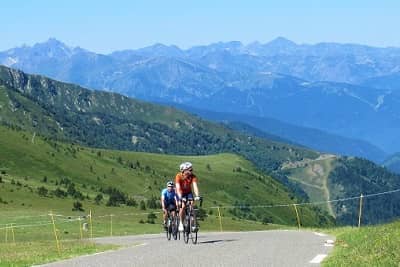The 20 Best Cycling Climbs in The Pyrenees
In this guide we list the top twenty cycling climbs in the French Pyrenees. It is, of course, entirely subjective, but based on our experience, we believe that these climbs should be towards the top of your 'must do' cycling list.
The climbs chosen are a combination of those with the best scenery, the quietest roads and also those which feature in the history of the Tour de France. Click on the title to find out more about each climb!
However, as you climb higher it is also interesting as the landscape changes to one of high mountains, as you transition towards the higher peaks of the Ariege and Hautes Pyrenees regions. The Coll de Jau is not particularly famous or challenging, but it perhaps best exemplifies the wide variety of scenery in this magnificent mountain range.
From a cycle tourists point of view, however, it is a brilliant little climb. The ascent from Azet is more enjoyable and scenic, although the climb from Genos has more hairpins and is also pleasant. Highlights include the views you get of some of the other nearby climbs - in particular the unusual perspectives of Pla d'Adet and the Col de Peyresourde.
With an average gradient of around 8% for 16km, stage winners here include the rather controversial trio of Lance Armstrong, Alberto Contador and Marco Pantani - perhaps giving you some insight into exactly what it takes to conquer this!
Plateau de Beille has very quiet roads and an excellent surface to ride on. The reason why it is not higher on the list is simply that most of the ascent is not that scenic. The final 3km are beautiful, as the trees open out and offer views across the valley. But, until then, there is not a great deal to see.
Ocaña crashed on the St Beat (west) side of the climb, which is the harder, but less scenic side. We recommend climbing from Pont l'Oule, where the ascent begins right from the bottom of the Col de Portet d'Aspet. This side has fantastic hairpin bends in the middle section, and a gradient which is challenging, but not as much of a grind as the long 10% sections on the other side.
The climb is enjoyable and fairly picturesque throughout, without ever being really spectacular. The final 3km are particularly enjoyable as hairpin bends take you to the grassy slopes above the tree line.
The scenery is fantastic, with luscious green landscapes so typical of the Basque region - although the rain and cloud which is common in this area often obscures it!
After a long and gentle start, the climb properly begins in Gedre, from where the gradients are inconsistent and sometimes steep. The scenery in the final 10km is stunning, as you ride into the Pyrenees National Park.
From Payolle the climb is irregular, but never hard, and the undulating green fields, filled with horses and cows makes for beautiful scenery. The road is usually quieter than neighbouring Col d'Aspin and, if you are heading west to east, it is the better option.
The road is quiet throughout, with the first 10km mostly in trees; initially following a river valley before looping up through the forest. Around 6km from the top, the trees finish and a series of hairpin bends take you to the ski resort at the top of the climb - with fine views of the Maladeta massif in the background.
It's only let down slightly by the rather ugly ski resort at the top (see photo below)!
With an average gradient of 8.5% in the final 10km, the road climbs to the Pailheres on a narrow road via a series of tight hairpins. They wind through open scenery, with marvellous views in all directions. On the descent, watch out for the cows and horses which often block the road!
The top of the climb is only 1km from the border with Spain - a border which is made up of some of the highest and most rugged peaks of the Pyrenees range. The scenery is fitting of National Park status, and makes the 30km climb from Luz St Sauveur well worth the effort.
There are three lakes towards the top of the climb, all of which are worth a visit and all of which are set amidst incredible scenery. The only downside to the climb is that, in the height of summer, the road can become fairly busy with hikers driving up to the car parks near the lakes.
The climb has hosted several Tour de France finishes - including that of the famous 'look' given from Lance Armstrong towards Jan Ullrich. The road is quiet, the scenery is great and it is challenging without ever being too steep. A superb climb.
The most scenic section of the Aubisque - the Cirque du Litor - is situated on the Argeles-Gazost side between the Col du Soulor and the Aubisque. A balcony road, built into the side of the mountain, the views from here are unique and offer an unusual dramatic perspective.
The most spectacular side is from Bastida, where the scenery is open and impressive throughout. The road is narrow and almost completely without traffic, and offers amazing panoramas across the Basque Pyrenees.
One word of caution though, Ahuski is hard. It is very inconsistent with sections at 14-15% gradient followed by sections of false flat. And the final 1.5km averages over 12%. Do it though. You won't regret it.
The lower part of the climb offers fine views across the St Lary valley (including of the Col d'Azet), while the upper section is much more remote and has the look and feel of intimidatingly high mountains. Col de Portet is a tough ascent, with the gradient averaging over 8% for 16km.
Situated across the valley from the Aubisque, the final 3km of Hautacam are particularly impressive, with the landscape becoming increasingly remote and isolated.
After climbing out of the village Bareges, you are treated to 10km of amazing mountain scenery, with dramatic peaks on both sides and a both impressive and intimidating view of the road snaking up to the pass ahead.
The Campan side is undoubtedly harder, but it is a bit of a slog with limited views until the final 3km - it does make for a great descent though! The only slight downside to Tourmalet is that the lower part of the climb can carry some traffic - but the road is wide so it is not really annoying, and it thins out considerably the higher you climb.
Rather, we believe that Port de Bales from Luchon is the best climb in the Pyrenees. Basically, because it has everything you could ask for in a cycling climb.
The road is very quiet and well surfaced. The gradients are mixed; with a steep section which is short enough not to become annoying, a really fun false flat, and a steady moderately hard climb via hairpin bends to the finish.
Most of all though, the scenery is superb. From the picturesque villages that you pass through, to the rolling grassy slopes of Mont Né near the top. All of which is framed to the south by views of the highest peaks in the Pyrenees - Aneto and Maladeta - glistening imperiously from the border with Spain.
Even if the photos don't do it justice, we believe that Port de Bales is the most enjoyable climb to ride in the Pyrenees for its tranquility and sheer joy!
So that's it. Let us know if you agree or disagree, and you may even be able to persuade us to update the list!
For more information about the Pyrenees, check out our climbs section where you can find a map and details of all the finest ascents in the region.
Also check out our cycling holidays to the region. Our Best of the Pyrenees cycling holiday is run both guided and self-guided, and crosses from the Basque Pyrenees to Luchon.
While our Pyrenees Coast to Coast holiday, as the name suggests, crosses the entire length of the Pyrenees, exploring each region.
Check out the links below for more information and the full itineraries of these tours.
The climbs chosen are a combination of those with the best scenery, the quietest roads and also those which feature in the history of the Tour de France. Click on the title to find out more about each climb!
20. Coll de Jau
The only climb in the list in the Catalan Pyrenees, and perhaps the only one you haven't already heard of! The Coll de Jau is best climbed from the Prades side, where it is a long and steady ascent. The bottom of the climb looks and feels very Mediterranean, passing through small stone villages - it is here where the scenery is at its most spectacular.However, as you climb higher it is also interesting as the landscape changes to one of high mountains, as you transition towards the higher peaks of the Ariege and Hautes Pyrenees regions. The Coll de Jau is not particularly famous or challenging, but it perhaps best exemplifies the wide variety of scenery in this magnificent mountain range.
19. Col d'Aspin
The Col d'Aspin is one of the more famous climbs in the Pyrenees. It is used regularly in the Tour de France and is generally included with much harder climbs nearby. The best side is to climb from Arreau; here the scenery is more open (including views over towards the impressive Maladeta massif), and the hairpin bends make riding a lot of fun.18. Col d'Azet
Col d'Azet is a regular in the Tour de France, but lacks the notoriety of some of the other passes in the area, probably because it is always overshadowed by a more important climb to the stage finish (Pla d'Adet / Col de Portet).From a cycle tourists point of view, however, it is a brilliant little climb. The ascent from Azet is more enjoyable and scenic, although the climb from Genos has more hairpins and is also pleasant. Highlights include the views you get of some of the other nearby climbs - in particular the unusual perspectives of Pla d'Adet and the Col de Peyresourde.
17. Plateau de Beille
One of the hardest climbs in the Pyrenees and one of the Tour's favourite stage finishes in the last two decades, Plateau de Beille could perhaps be slightly higher on the list.With an average gradient of around 8% for 16km, stage winners here include the rather controversial trio of Lance Armstrong, Alberto Contador and Marco Pantani - perhaps giving you some insight into exactly what it takes to conquer this!
Plateau de Beille has very quiet roads and an excellent surface to ride on. The reason why it is not higher on the list is simply that most of the ascent is not that scenic. The final 3km are beautiful, as the trees open out and offer views across the valley. But, until then, there is not a great deal to see.
16. Col de Mente
Col de Mente came to international attention in 1971 when Luis Ocaña - leading the Tour de France by seven minutes - crashed on the descent of its slopes. He was on track to break Eddy Merckx's monopoly of the race before the incident - perhaps changing the course of cycling history.Ocaña crashed on the St Beat (west) side of the climb, which is the harder, but less scenic side. We recommend climbing from Pont l'Oule, where the ascent begins right from the bottom of the Col de Portet d'Aspet. This side has fantastic hairpin bends in the middle section, and a gradient which is challenging, but not as much of a grind as the long 10% sections on the other side.
15. Col de Peyresourde
One of the most famous climbs in the Pyrenees, only the Aubisque and Tourmalet have appeared more often in the Tour de France than the Peyresourde. The ascent from Luchon is the more scenic and varied of the two sides.The climb is enjoyable and fairly picturesque throughout, without ever being really spectacular. The final 3km are particularly enjoyable as hairpin bends take you to the grassy slopes above the tree line.
14. Port Larrau
Port Larrau is quite possibly the hardest climb that the Tour de France has ever tackled in the Pyrenees. Situated in the Basque region, and climbing to the border between France and Spain, Larrau is characterized by very steep gradients on the French side. With long sections at around 14%.The scenery is fantastic, with luscious green landscapes so typical of the Basque region - although the rain and cloud which is common in this area often obscures it!
13. Cirque de Troumouse
An under-rated climb - the Cirque de Troumouse is overshadowed somewhat by its higher and more impressive neighbour - the Cirque de Gavarnie (see below for more). But it is a very enjoyable climb in its own right.After a long and gentle start, the climb properly begins in Gedre, from where the gradients are inconsistent and sometimes steep. The scenery in the final 10km is stunning, as you ride into the Pyrenees National Park.
12. Hourquette d'Ancizan
A relative newcomer to the Tour de France, Hourquette d'Ancizan is a superb climb. The harder side is from the village of Ancizan, but the much more scenic side is from Payolle - and is our recommended way of ascending.From Payolle the climb is irregular, but never hard, and the undulating green fields, filled with horses and cows makes for beautiful scenery. The road is usually quieter than neighbouring Col d'Aspin and, if you are heading west to east, it is the better option.
11. Superbagneres
Superbagneres has fallen out of favour with the Tour de France in the last few years, with the race preferring to finish in the town of Luchon. Don't let that put you off though, because this is a fantastic climb.The road is quiet throughout, with the first 10km mostly in trees; initially following a river valley before looping up through the forest. Around 6km from the top, the trees finish and a series of hairpin bends take you to the ski resort at the top of the climb - with fine views of the Maladeta massif in the background.
It's only let down slightly by the rather ugly ski resort at the top (see photo below)!
10. Port de Pailheres
One of only two paved passes in the Pyrenees over 2,000m (the other, of course, being Tourmalet) Port Pailheres is a spectacular climb. Both sides are challenging and picturesque, but the climb from Usson-les-Bains (east side) just edges it in our opinion.With an average gradient of 8.5% in the final 10km, the road climbs to the Pailheres on a narrow road via a series of tight hairpins. They wind through open scenery, with marvellous views in all directions. On the descent, watch out for the cows and horses which often block the road!
9. Cirque de Gavarnie
Cirque de Gavarnie is best known as one of the best hiking routes in the Pyrenees. However, there is also a fantastic climb here for cyclists (also known as the Col de Tentes). Ascending through the National Park to nearly 2,300m, this is undoubtedly one of the most scenic roads in the mountain range.The top of the climb is only 1km from the border with Spain - a border which is made up of some of the highest and most rugged peaks of the Pyrenees range. The scenery is fitting of National Park status, and makes the 30km climb from Luz St Sauveur well worth the effort.
8. Route des Lacs
Similar to Cirque de Gavarnie, the Route des Lacs is one of the highlights of the Pyrenees, but may not be on the radar of many cyclists as it has never been used in the Tour de France. Like Gavarnie, this is due to its National Park protected status, rather than because it is deemed to be unworthy of the race.There are three lakes towards the top of the climb, all of which are worth a visit and all of which are set amidst incredible scenery. The only downside to the climb is that, in the height of summer, the road can become fairly busy with hikers driving up to the car parks near the lakes.
7. Luz Ardiden
The hairpin bends at the top of Luz Ardiden are perhaps the iconic image of the Pyrenees. Situated in the final 4km of the climb, where the gradient begins to ease from 9% to 6%, these are the undoubted highlight of the Luz Ardiden.The climb has hosted several Tour de France finishes - including that of the famous 'look' given from Lance Armstrong towards Jan Ullrich. The road is quiet, the scenery is great and it is challenging without ever being too steep. A superb climb.
6. Col d'Aubisque
One of the most famous and popular climbs in the Pyrenees, Col d'Aubisque should be on the list of all cyclists coming to the region. Both sides (or all three if you include the ascent from Ferrieres via the Col du Soulor) are well worth doing, though the climb from Laruns is generally seen as the 'classic' side.The most scenic section of the Aubisque - the Cirque du Litor - is situated on the Argeles-Gazost side between the Col du Soulor and the Aubisque. A balcony road, built into the side of the mountain, the views from here are unique and offer an unusual dramatic perspective.
5. Ahuski
Ahuski (also known as Ahusquy in French) is the greatest climb of the Basque Pyrenees. You have probably never heard of it and are wondering what its doing in this list above the likes of Aubisque and Luz Ardiden. However, we stand by the decision - as Ahuski is a stunning climb.The most spectacular side is from Bastida, where the scenery is open and impressive throughout. The road is narrow and almost completely without traffic, and offers amazing panoramas across the Basque Pyrenees.
One word of caution though, Ahuski is hard. It is very inconsistent with sections at 14-15% gradient followed by sections of false flat. And the final 1.5km averages over 12%. Do it though. You won't regret it.
4. Col de Portet
First used in the 2018 Tour de France (it was only paved earlier in the same year), the Col de Portet has instantly become a hit with cycling aficionados. The first part of the climb is the same as long time Tour de France stage finish Pla d'Adet. However, just as the gradient starts to ease towards the top of Pla d'Adet, the road turns to the right and a long series of hairpins take you up to the 2,215m high Col de Portet.The lower part of the climb offers fine views across the St Lary valley (including of the Col d'Azet), while the upper section is much more remote and has the look and feel of intimidatingly high mountains. Col de Portet is a tough ascent, with the gradient averaging over 8% for 16km.
3. Hautacam
Hautacam is perhaps the most iconic of all the ski resort climbs in the Pyrenees, and will continue to grow in stature. It may not have the fame yet of an Alpe d'Huez, but it is a much nicer climb. The road is very quiet and has inconsistent gradients, but with easier sections coming just at the right time, and the scenery is excellent.Situated across the valley from the Aubisque, the final 3km of Hautacam are particularly impressive, with the landscape becoming increasingly remote and isolated.
2. Col du Tourmalet
By far the most famous climb in the Pyrenees - the Col du Tourmalet has been used more often in the Tour de France than any other climb. Both sides are long and challenging, but we much prefer the Luz St Sauveur side. This is the slightly easier side, but by far the more scenic.After climbing out of the village Bareges, you are treated to 10km of amazing mountain scenery, with dramatic peaks on both sides and a both impressive and intimidating view of the road snaking up to the pass ahead.
The Campan side is undoubtedly harder, but it is a bit of a slog with limited views until the final 3km - it does make for a great descent though! The only slight downside to Tourmalet is that the lower part of the climb can carry some traffic - but the road is wide so it is not really annoying, and it thins out considerably the higher you climb.
1. Port de Bales
You may be thinking this is something of a controversial choice for first place. What's more, we're not even recommending the 'classic' side from Mauleon-Barousse - the only side ever climbed in the Tour de France.Rather, we believe that Port de Bales from Luchon is the best climb in the Pyrenees. Basically, because it has everything you could ask for in a cycling climb.
The road is very quiet and well surfaced. The gradients are mixed; with a steep section which is short enough not to become annoying, a really fun false flat, and a steady moderately hard climb via hairpin bends to the finish.
Most of all though, the scenery is superb. From the picturesque villages that you pass through, to the rolling grassy slopes of Mont Né near the top. All of which is framed to the south by views of the highest peaks in the Pyrenees - Aneto and Maladeta - glistening imperiously from the border with Spain.
Even if the photos don't do it justice, we believe that Port de Bales is the most enjoyable climb to ride in the Pyrenees for its tranquility and sheer joy!
So that's it. Let us know if you agree or disagree, and you may even be able to persuade us to update the list!
For more information about the Pyrenees, check out our climbs section where you can find a map and details of all the finest ascents in the region.
Also check out our cycling holidays to the region. Our Best of the Pyrenees cycling holiday is run both guided and self-guided, and crosses from the Basque Pyrenees to Luchon.
While our Pyrenees Coast to Coast holiday, as the name suggests, crosses the entire length of the Pyrenees, exploring each region.
Check out the links below for more information and the full itineraries of these tours.
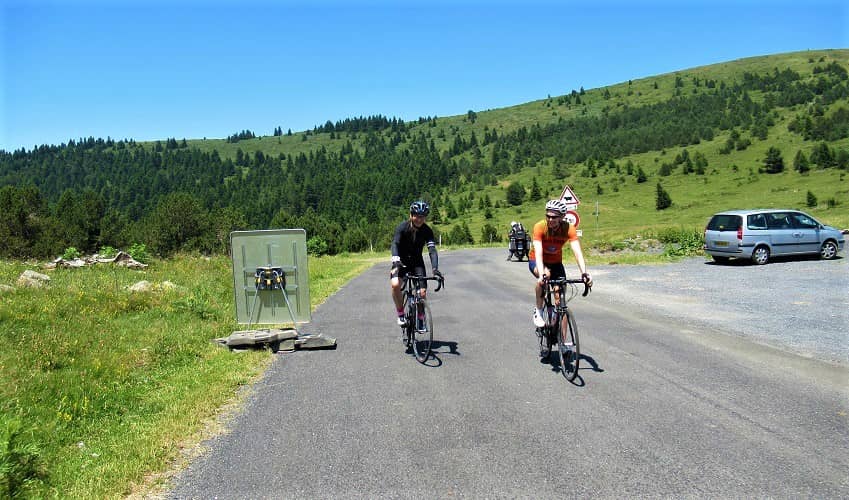
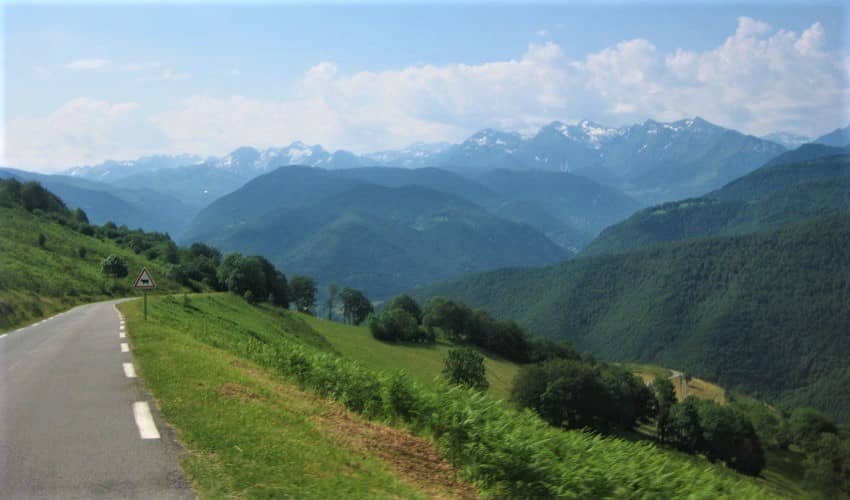
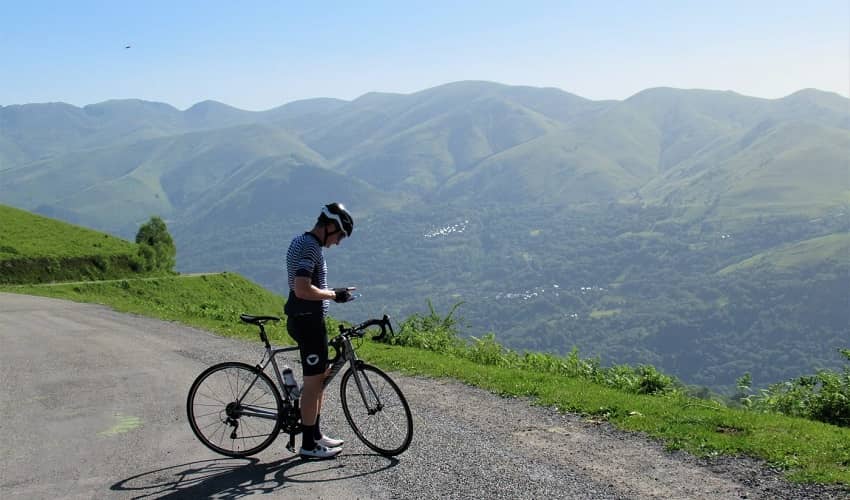
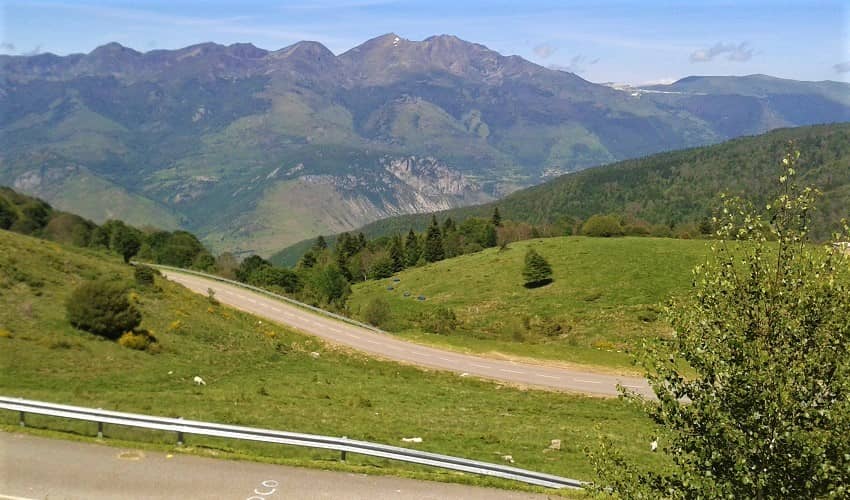
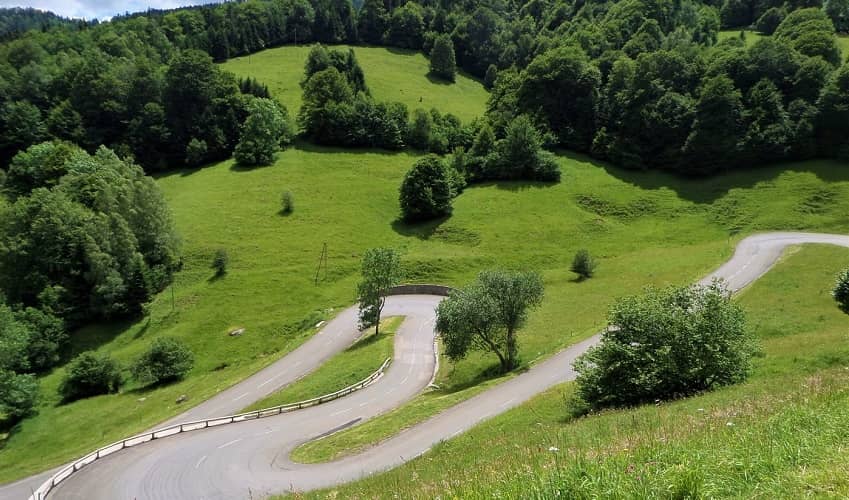
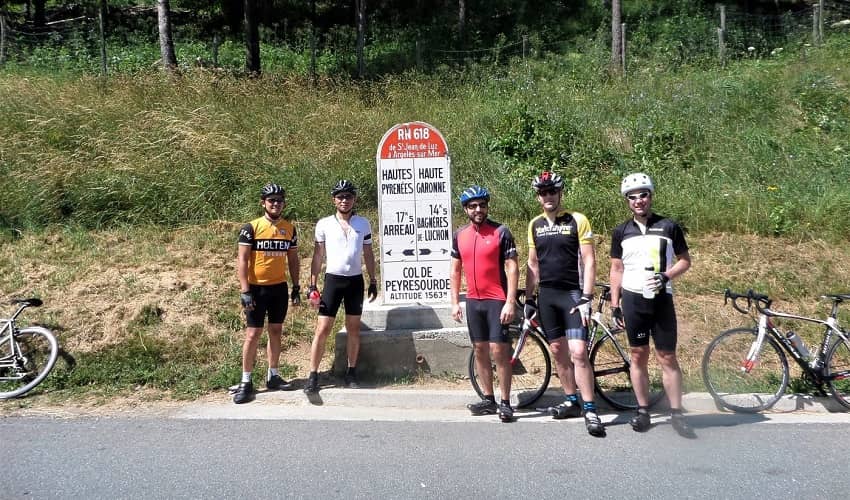
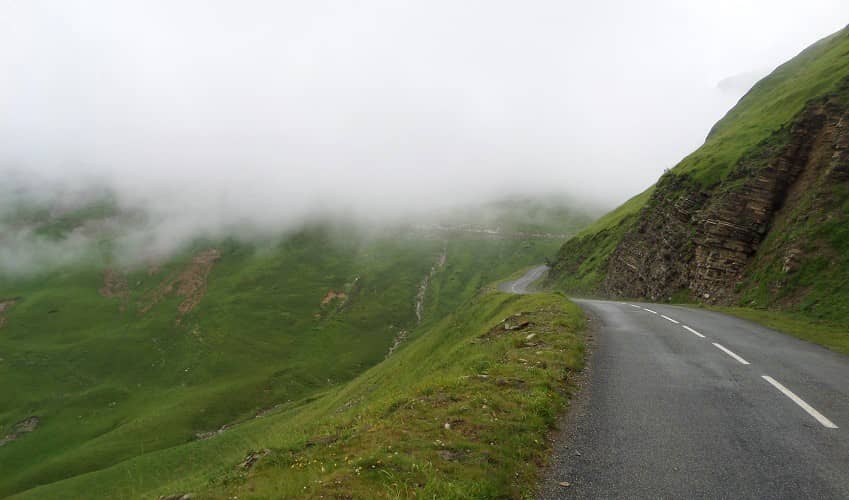
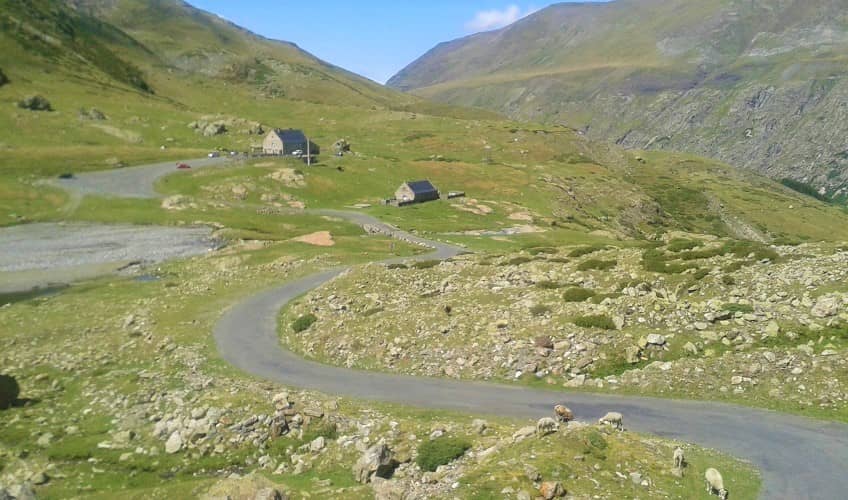
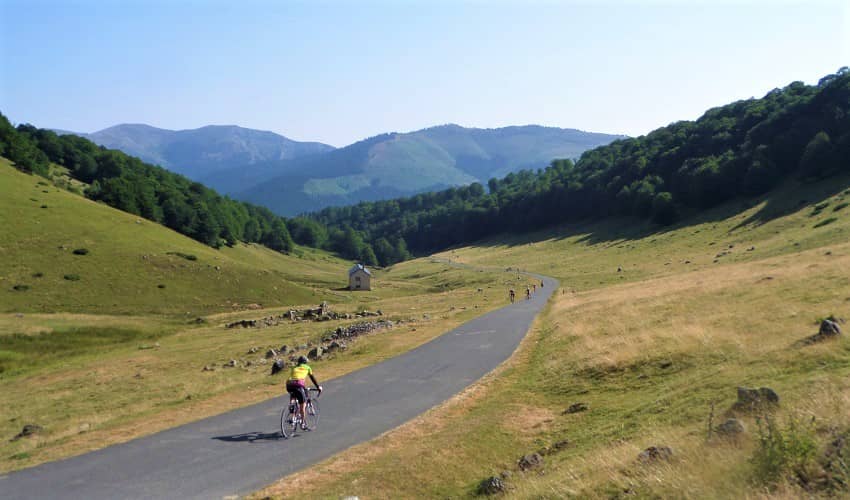
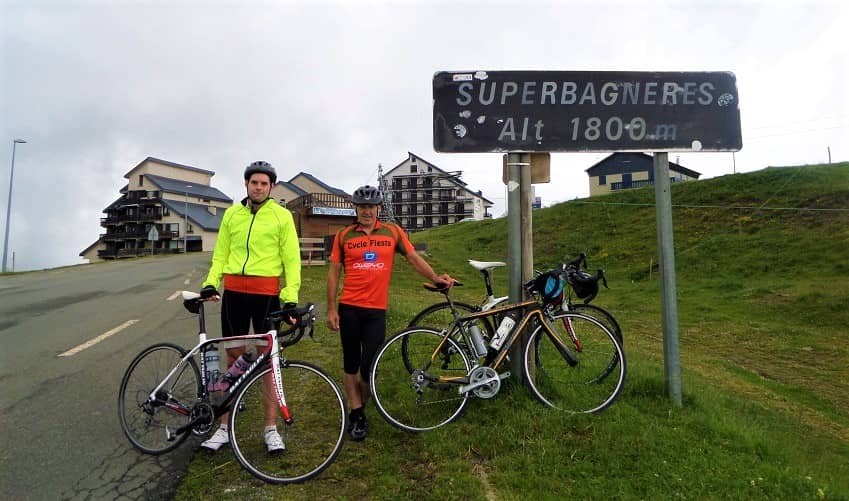
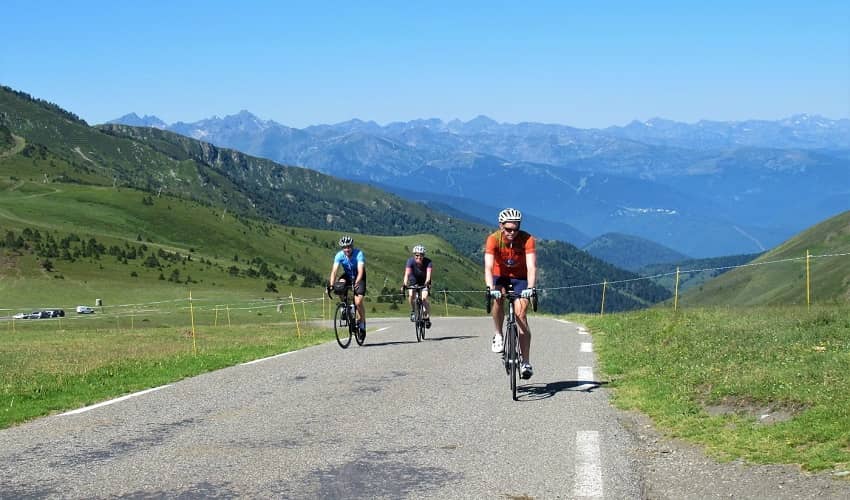
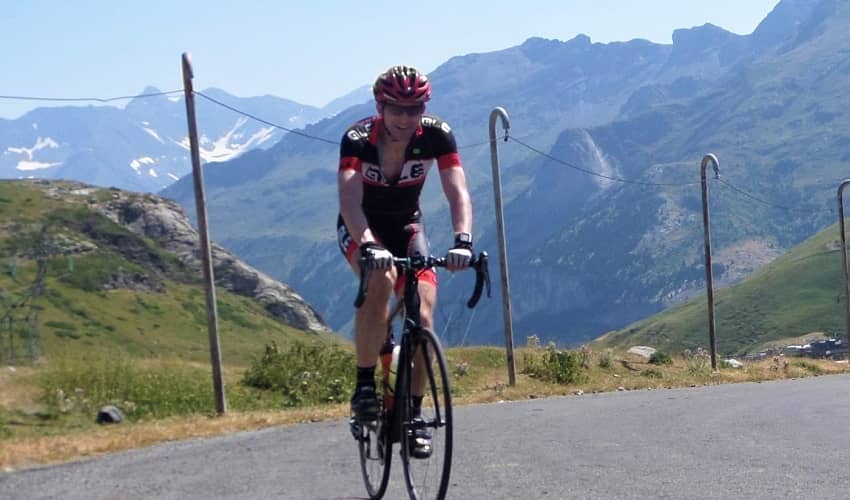
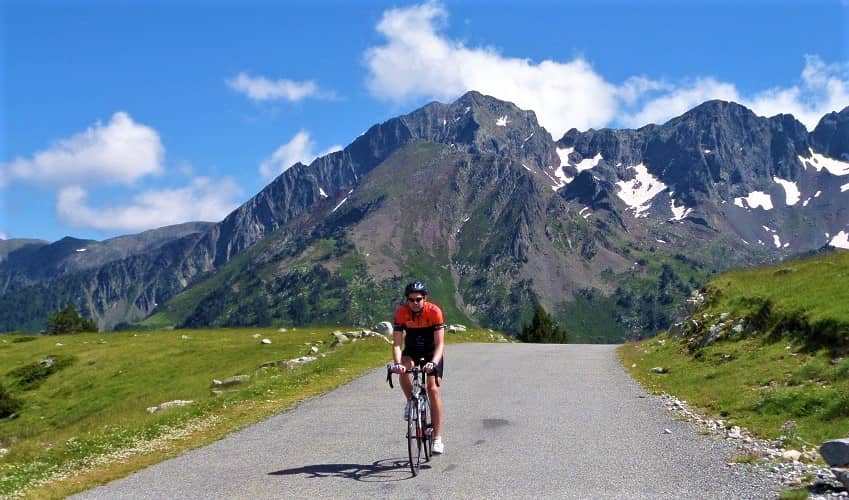
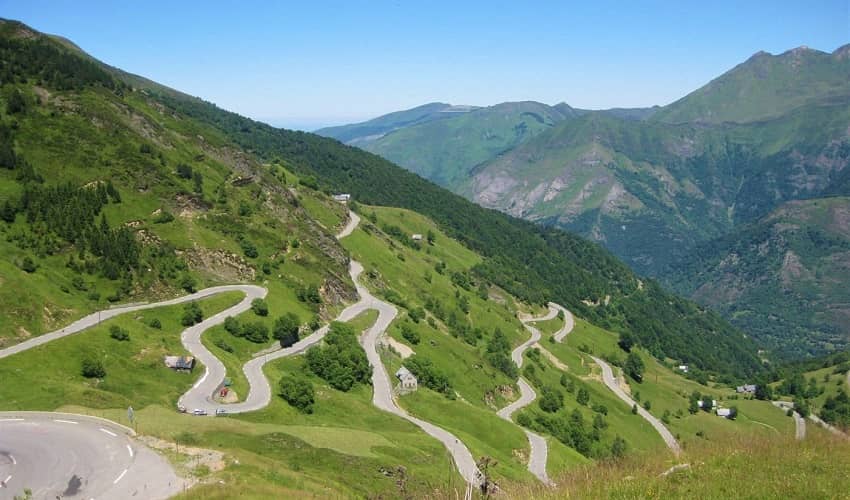
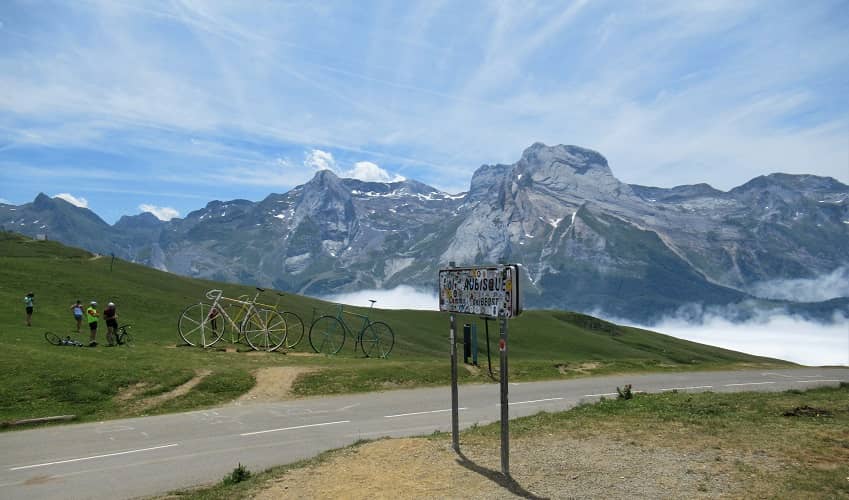
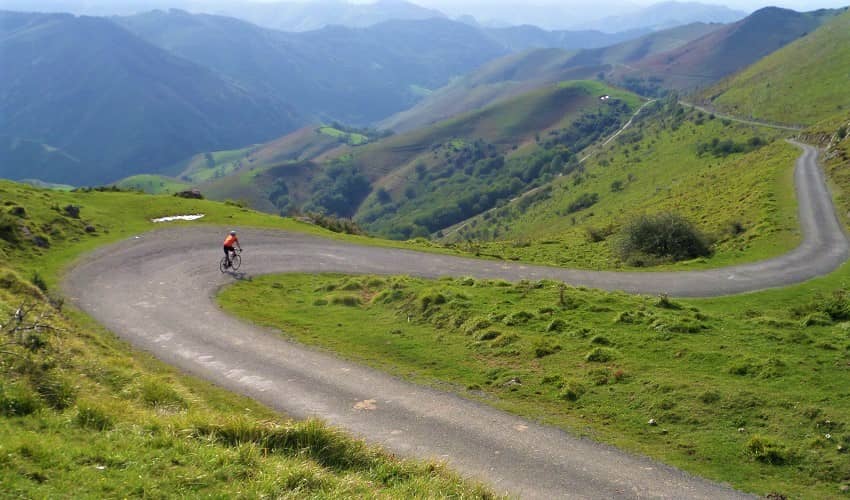
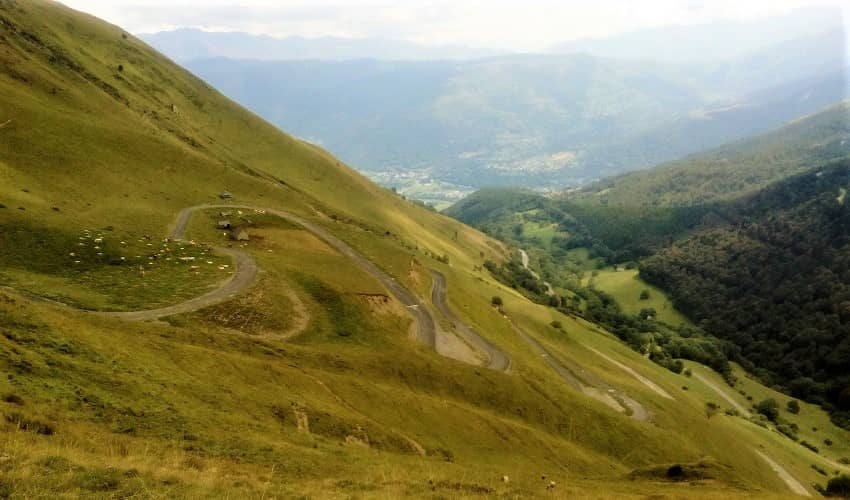
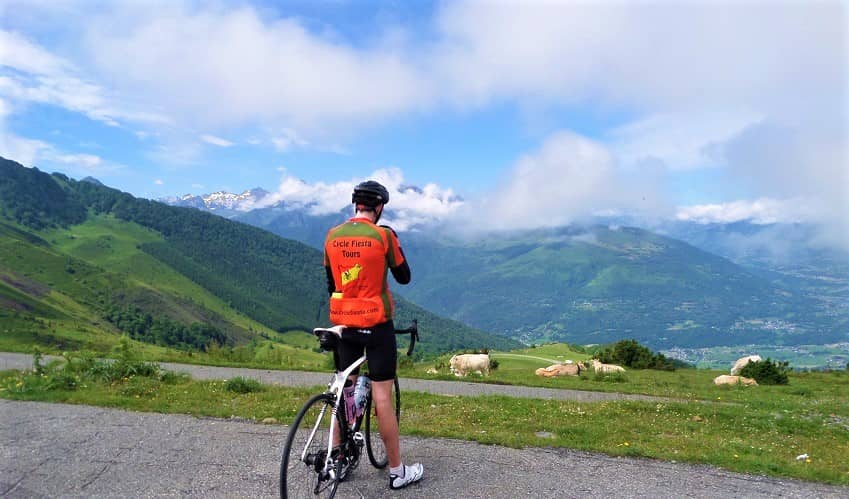
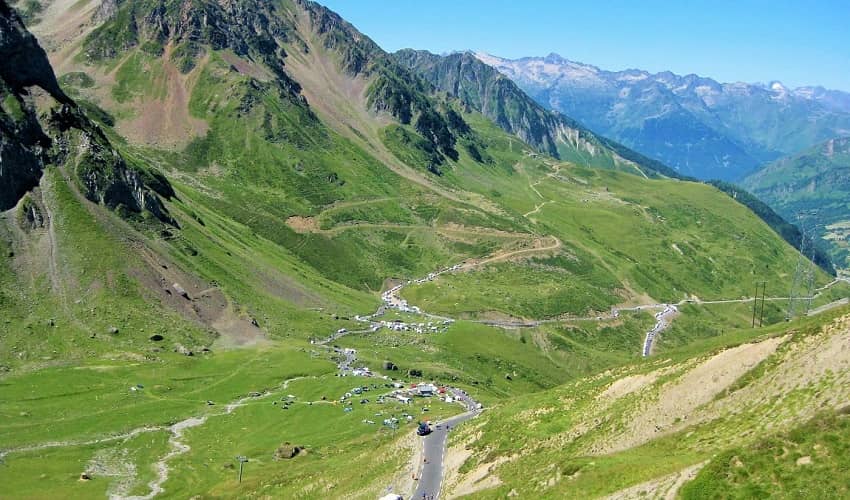
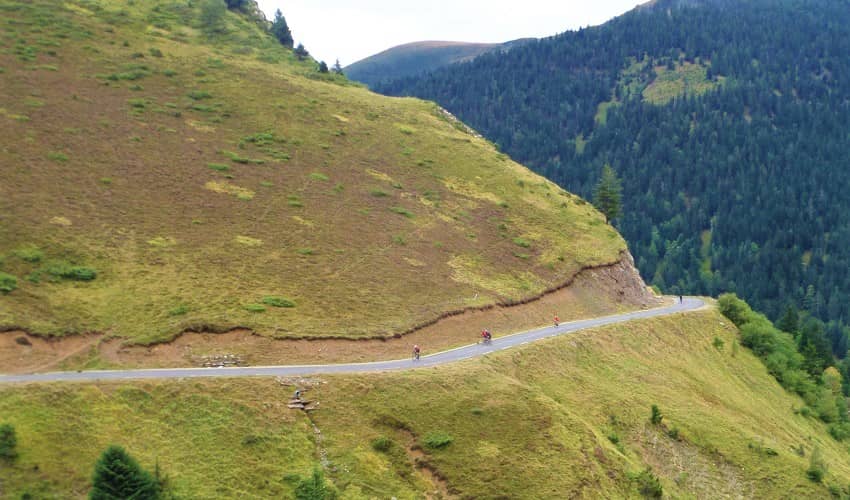
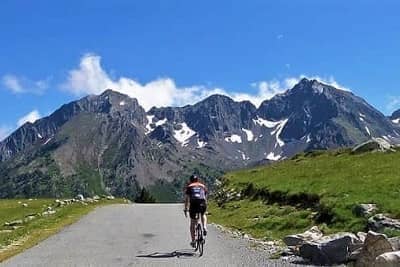
 France
France
